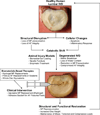Role of biomechanics in intervertebral disc degeneration and regenerative therapies: what needs repairing in the disc and what are promising biomaterials for its repair?
- PMID: 23369494
- PMCID: PMC3612376
- DOI: 10.1016/j.spinee.2012.12.002
Role of biomechanics in intervertebral disc degeneration and regenerative therapies: what needs repairing in the disc and what are promising biomaterials for its repair?
Abstract
Background context: Degeneration and injuries of the intervertebral disc (IVD) result in large alterations in biomechanical behaviors. Repair strategies using biomaterials can be optimized based on the biomechanical and biological requirements of the IVD.
Purpose: To review the present literature on the effects of degeneration, simulated degeneration, and injury on biomechanics of the IVD, with special attention paid to needle puncture injuries, which are a pathway for diagnostics and regenerative therapies and the promising biomaterials for disc repair with a focus on how those biomaterials may promote biomechanical repair.
Study design: A narrative review to evaluate the role of biomechanics on disc degeneration and regenerative therapies with a focus on what biomechanical properties need to be repaired and how to evaluate and accomplish such repairs using biomaterials. Model systems for the screening of such repair strategies are also briefly described.
Methods: Articles were selected from two main PubMed searches using keywords: intervertebral AND biomechanics (1,823 articles) and intervertebral AND biomaterials (361 articles). Additional keywords (injury, needle puncture, nucleus pressurization, biomaterials, hydrogel, sealant, tissue engineering) were used to narrow the articles down to the topics most relevant to this review.
Results: Degeneration and acute disc injuries have the capacity to influence nucleus pulposus (NP) pressurization and annulus fibrosus (AF) integrity, which are necessary for an effective disc function and, therefore, require repair. Needle injection injuries are of particular clinical relevance with the potential to influence disc biomechanics, cellularity, and metabolism, yet these effects are localized or small and more research is required to evaluate and reduce the potential clinical morbidity using such techniques. NP replacement strategies, such as hydrogels, are required to restore the NP pressurization or the lost volume. AF repair strategies including cross-linked hydrogels, fibrous composites, and sealants offer promise for regenerative therapies to restore AF integrity. Tissue engineered IVD structures, as a single implantable construct, may promote greater tissue integration due to the improved repair capacity of the vertebral bone.
Conclusions: IVD height, neutral zone characteristics, and torsional biomechanics are sensitive to specific alterations in the NP pressurization and AF integrity and must be addressed for an effective functional repair. Synthetic and natural biomaterials offer promise for NP replacement, AF repair, as an AF sealant, or whole disc replacement. Meeting mechanical and biological compatibilities are necessary for the efficacy and longevity of the repair.
Copyright © 2013 Elsevier Inc. All rights reserved.
Figures







References
-
- Adams MA, Roughley PJ. What is intervertebral disc degeneration, and what causes it? Spine. 2006;31(18):2151–2161. - PubMed
-
- Lotz JC, Ulrich JA. Innervation, inflammation, and hypermobility may characterize pathologic disc degeneration: review of animal model data. J Bone Joint Surg Am. 2006;88(Suppl 2):76–82. - PubMed
-
- Mok FP, Samartzis D, Karppinen J, Luk KD, Fong DY, Cheung KM. ISSLS prize winner: Prevalence, determinants, and association of Schmorl nodes of the lumbar spine with disc degeneration: a population-based study of 2449 individuals. Spine (Phila Pa 1976) 2010;35(21):1944–1952. - PubMed
-
- Williams FM, Manek NJ, Sambrook PN, Spector TD, Macgregor AJ. Schmorl's nodes: common, highly heritable, and related to lumbar disc disease. Arthritis Rheum. 2007;57(5):855–860. - PubMed
Publication types
MeSH terms
Substances
Grants and funding
LinkOut - more resources
Full Text Sources
Other Literature Sources
Miscellaneous

